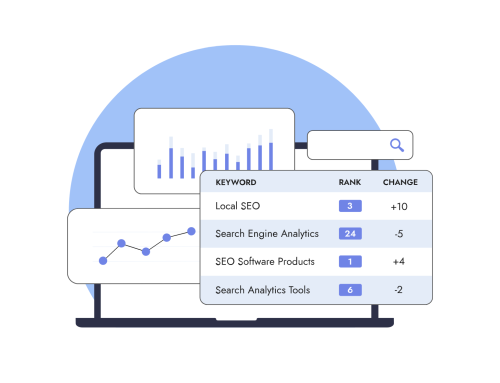Search Engine Optimization (SEO) isn’t possible without keywords. Without them, you can’t find people’s interests. If your content is about things or a niche that no one is interested in, you don’t get any traffic to your website, irrespective of your skills or effort.
Table of Contents
What is keyword research?
Keywords are the phrases or words people type into Google, Bing, and other search engines. With keyword research, you can figure out the language used by your target customers when they search for content, products, and services. This process lets you conduct a comparative analysis and figure out the best use of keywords to increase the organic traffic on your website.
Keyword research is indispensable so that you can avoid writing content that doesn’t have a niche audience and isn’t searched for. You don’t want to waste your time, energy, and resources on creating content that doesn’t drive traffic. Moreover, keyword research lets you know about:
- The difficulty of ranking for a certain keyword
- Potential traffic when you rank for a keyword
- Content that should be created to rank for a keyword
- CTR rate for potential traffic
How to find and choose keywords for your business
To choose keywords, you need to have a good understanding of the way your potential customers think when they search for a blog or business. There are numerous effective ways to choose your keywords and create a sound keyword research strategy. Here are a few of them:
Conceptualize “seed” keywords
Seed keywords lay the foundation of your keyword research and help you locate your competitors on the web. If you own an online business that needs to be promoted, brainstorming seed keywords is your cup of tea. Think about the words or phrases people may type into the Google search box when they want to find your business. For instance, if you write about landscaping, the seed keywords may be landscape, garden, aerator, lawnmower, and more such keywords.
Find out the keywords that rank your competitors
Once you have a few seed keywords, you can use them to identify your competitors. To do that, search on Google with your seed keyword and identify the top rankers on your search result. If the top rankers aren’t similar to your website, use Google’s auto-suggest queries to find relevant keywords that may show your real competitors. For instance, “landscape” may not show your real competitors – landscaping blogs. You may need to narrow down your results with something like “landscape design”. Once you have a list of competitive websites, you can feed them into the competitive analysis tool of Zutrix and find out their top-ranking keywords.
Keyword research tools
Keyword research tools can be very helpful to find out keywords that may have been missed by your competition. These tools accept a seed keyword and show you numerous keyword ideas that match with their database. One of the most well-known keyword research tools is the Google Keyword Planner. Yes, it was built for advertisers and is primarily used by them. However, it is free and allows you to do excellent keyword research for SEO.
If you want a better alternative, there are several keyword research tools on the market. However, most of them aren’t budget-friendly for beginners and their free versions have limited functionality. You may as well opt for the affordable keyword research tool that is provided by Zutrix. Basic plans start as low as $28 every month and you get a decent discount if you go for the annual billing.
Know your niche
You can generate an overwhelming number of keyword ideas with keyword research tools. However, the process is limited since it makes use of your seed keywords. Some good ideas may fly under your radar if you limit yourself in a closed loop. To solve this problem, you need to browse through online groups, forums, Q&A sites, subreddits, and more to understand your niche with greater depth.
For instance, a customer may be struggling with the replacement of batteries for his electric lawnmower and asked a question – “What is the charging cycle of my lawnmower battery and when to replace it?”. When you plug that topic into the keyword research tool of Zutrix, you may find it has a high volume. However, this keyword idea would be missed if you only relied on tools.
How to analyze keywords
You have a ton of keyword ideas and have managed to shrink down your list to a manageable number. Great! The next challenge is to figure out what works best. The best solution is to use SEO metrics and separate the cream of the crop. Some of the most important and highly used SEO metrics are:
- Clicks
- Search Volume
- Keyword Difficulty
- Traffic Potential
- Cost Per Click(CPC)
With SEO metrics, you can filter out high volume and low volume keywords and use them according to your needs. For instance, if you have a new site, you don’t want the extra competition of high-volume keywords. Similarly, Clicks, Traffic potential, CTR, and other metrics help you to narrow down your keyword portfolio for the best results.
Keyword Difficulty
Professionals gauge the difficulty of a keyword from numerous factors, including:
- Domain Rating
- Use of target keyword, entities, synonyms
- Branding
- Search intent
- Quality and count of backlinks, etc
Zutrix takes all those factors into account and shows you the keyword difficulty so that you can make the best use of that information. It is easier to shave off traffic from lower-difficulty keywords. As an additional failsafe you should also manually assess the keywords.
Conclusion
As business owners and content marketers, your keyword is as valuable as its business potential. After you have researched and decided on keywords, you can use them to improve existing content on your website or create new pages. Zutrix has all the necessary keyword research tools and SEO metrics that help you attract the right kind of traffic who are more likely to leave as customers.





